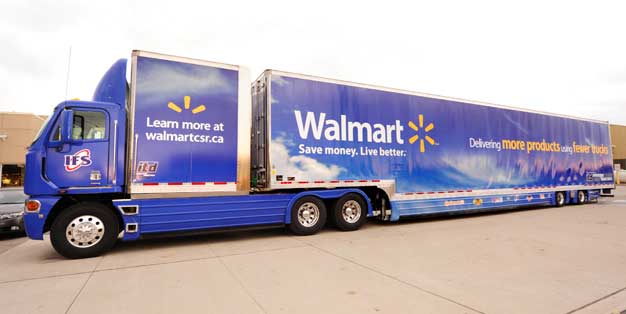Well there is no doubt that some combination of a desire to save money and a desire to reduce greenhouse gas emissions (in whatever proportion it happens to be for any given company) is leading to significant innovation in the trucking industry.
A few weeks ago, Supply Chain Digest published an article on a series of new truck designs on the way to market that are said to significantly reduce wind resistance and thus improve fuel efficiency. (See European Expo Features New Highly Aerodynamic Tractor-Trailer Designs.)
Now, news that Walmart is testing in Canada a new concept truck it calls Supercube, with several major changes in design that lead to as much as a 30% increase in total cube available.
As shown in the image below, the pilot vehicles use a 60.5-foot long trailer, versus the standard 53-foot trailer design, plus adds a separate "drome box" that sits between the tractor and the traditional trailer.
All this fits in the total length of a regular truck with a 53-foot trailer, made possible in large part from use of a squashed cab that puts the driver right up at the front. The interior floor of the Supercube's trailer is lower, and there's a built-in scissor lift inside to help loaders s move cargo into the cab interior.
The new truck was designed and built in Ontario, in partnership with Innovative Trailer Design. The trailer itself is 60.5 feet long, 7.5-ft. longer than the industry standard. The lower floor and longer length interior increases trailer capacity by 28%, offering 5,100 cubic feet of storage, and the drome box adds another 521 cubic feet of carrying capacity, raising the total increase in cube to 30%. The trailer is pulled by a Freightliner cabover tractor.
The interior scissor lift is capable of handling 15,000 pounds, so a forklift can be used to stock the front section of the trailer. A bogie airbag lift system raises the height of the trailer to meet the standard loading dock height of four feet.
The drome box, which can hold four pallets, and rolls to the rear of the truck frame so it can also be loaded and unloaded by forklift.
Walmart Supercube Truck/Trailer

Andy Ellis, SVP of supply chain and logistics for Walmart Canada, introduced the design at Canada's 2012 Transportation Sustainability Conference last week.
Walmart said then it had received permission from Ontario province's Ministry of Transportation (MTO) to conduct a pilot project to test two tractors and four trailers to demonstrate the units are capable of being operated safely.
That caused a minor stir from the Ontario Trucking Association (OTA), which noted that having the shipper responsible for conducting the pilot and for ensuring the safe operation of the trucks and trailers would be a break from protocol. Until now, it has been the actual carrier that received the permits and held these responsibilities. Walmart has said Interstate Freight Systems is the carrier it plans to use for the test.
But that issue seems to have somewhat gone away, as the MTO said that pilot will follow the existing norms, giving the permits to the carrier not to Walmart, after assuring the selected carrier has a good safety record.
The pilot program has not yet commenced, the MTO said, and there is no clear time frame for when the pilot will begin.
However, it does appear Walmart itself did at minimum receive some kind of special permit before it elected to build the equipment.
In addition, a Canadian logistics magazine (Truck News) located a Memorandum of Understanding document between the Ontario Registrar of Motor Vehicles and Walmart Canada Corp. that seems to indicate the necessary permits did go to Walmart.
It reads: "The Registrar of Motor Vehicles, by authority of Section 110.1 of the Highway Traffic Act, agrees to issue Special Permits authorizing Walmart to operate extended semi-trailers on Ontario roads and highways." The end of the document reiterates: "This MoU will remain in force as long as Walmart holds Special Permits."
Canadian truckers are not pleased with the process, no doubt in part because the additional capacity would in the end mean less demand for trucks and drivers if it became an industry standard.
Interestingly, Ellis said Walmart is happy to share its innovation.
"We've always said that sustainability is not a competitive advantage. We'll share the knowledge and technology put into this truck with anyone who's interested," Ellis commented at the conference.
The ability of the new design to benefit shippers would of course be constrained by the shipment "weighing out" before the extra cube capacity was realized. However, many sectors, especially soft goods retail, likely could use the full additional capacity.
What's your reaction to the Supercube? Did Walmart have to come up with this design because the carrier customers of truck/trailer manufacturers really don't want more cube efficient vehicles? Let us know your thoughts at the Feedback button below.

|